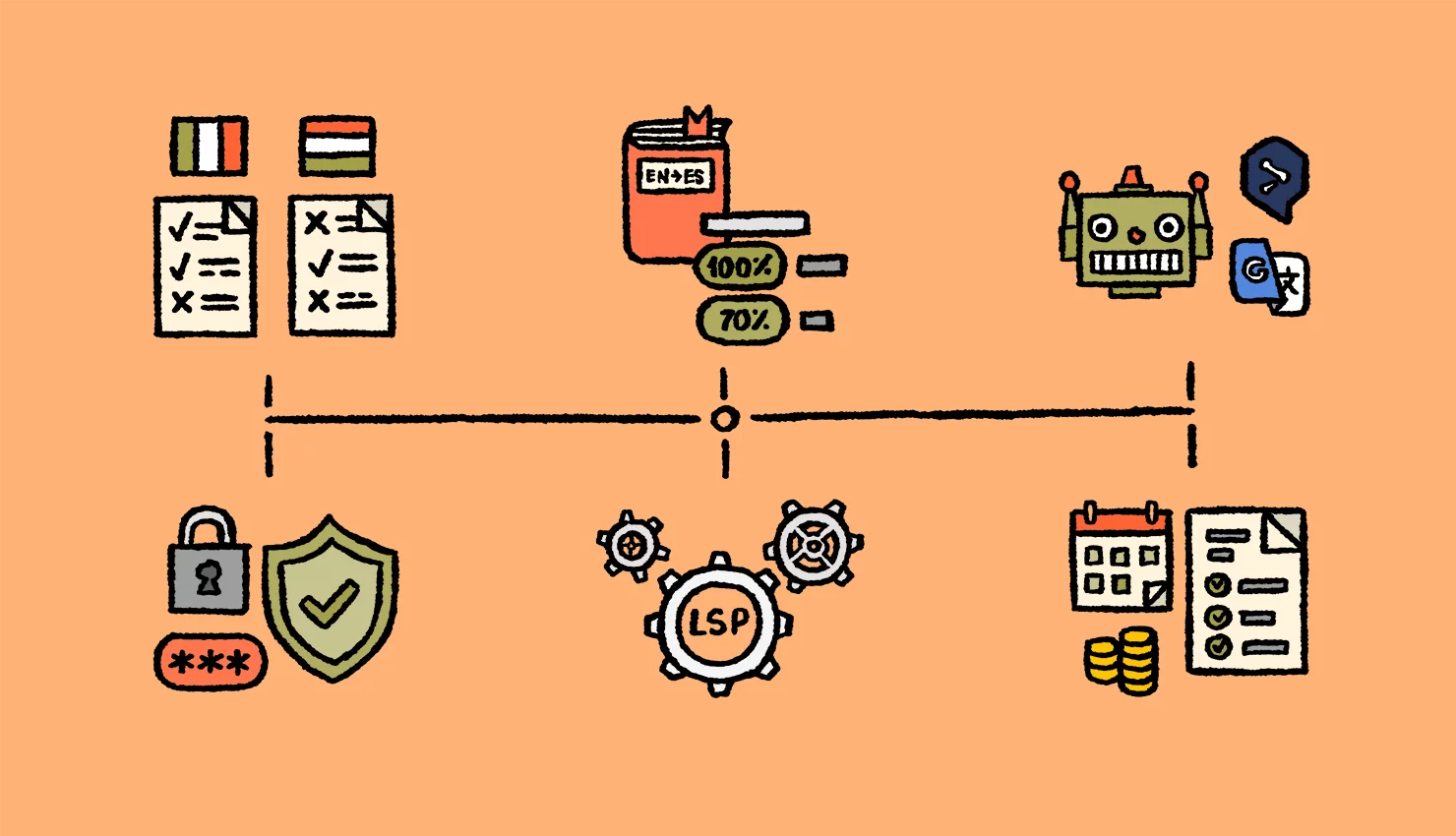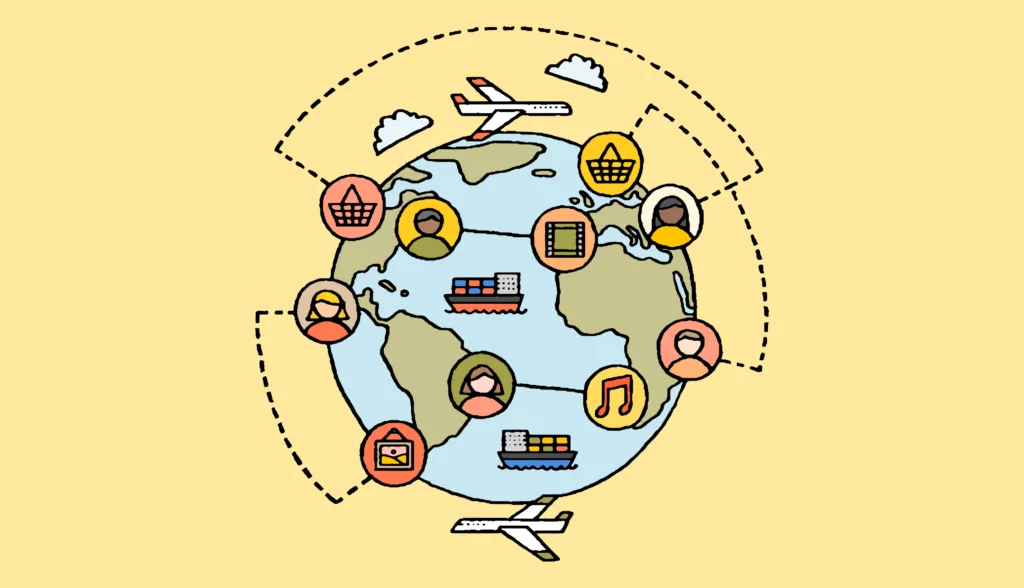No matter what type of business you lead – a growing fintech startup or an established corporation – chances are you will rely on the expertise to steer your financial translation efforts.
Successful localization in finance depends on collaboration with your language partner to deliver the best results for you and your customers. But choosing, reviewing, discussing, and onboarding capable, specialized LSPs is time-consuming.
If you’re wondering how to pick, evaluate, and onboard the right LSP for financial translations – read this guide, which includes actionable tips from vendors and financial companies.
Want to tackle other fintech localization challenges as well?
Download the ebook to learn from experts at Google, Western Union, Crypto.com, TransferGo, Remitly, Revolut, and more.
What are financial translations?
Financial translations represent the process of translating financial documents, reports, and statements in accordance with industry standards. This can include any type of finance-related content such as financial reports, invoices, bank statements, audit reports, accounting documents, business plans, financial news, and insurance documents among others.
Banks, FinTech’s, HR and digital coin platforms, and even financial news outlets, will all have to deal with financial translations since most of these companies operate on a global level. The complexity of financial translations means translators need an understanding of the industry terminology and principles so that nothing gets lost in translation which could end in financial disaster. For example, a “bear market” cannot be translated word for word.
Examples of financial translation in various industries
Financial translation is critical in sectors such as banking, insurance, investment, and any other industry where international accounting or transactions are involved. Some examples of financial documents that often require translation include annual reports, balance sheets, income statements, audit reports, financial contracts, taxation documents, terms and conditions, and business plans.
Here are some more examples of financial documents that may be translated across different industries:
| Industry | Document examples |
| Banking and finance | Bank statements, foreign transaction reports, investment portfolios, insurance policies, financial summaries |
| Healthcare and Pharmaceuticals | Financial responsibility agreements, purchase orders from suppliers based in different countries, foreign taxation documents, and pharmaceutical sales reports |
| Technology | Software purchase agreements, technology patents, merger and acquisition contracts, sales reports |
| Real Estate | Property valuation reports, sales contracts, property management agreements, and financial legal documents |
Narrowing down your LSP options
You’re well aware of the highly regulated, complex systems and terminology in finance that make finding the right translation partner a pain. The first step is to narrow down your options by disqualifying prospects that are a poor fit upfront.
Asking yourself what you want in a LSP partner is a must but sorting out the answer to this question can be challenging. The key is to select several specific business challenges that your organization faces and then form the evaluation around your needs.
Generic questions yield generic answers. In contrast, specific questions yield specific, actionable solutions. You’ll get more valuable insights if you ask your potential LSP partner targeted questions based on your unique challenges.
Here are three questions that should eliminate the bulk of your options:
- Does the LSP have specialized solutions to support the specific needs of financial organizations?
- Do they have proof? Look for finance company testimonials and case studies.
- Are their linguists subject matter experts in financial technology, crypto, blockchain, retail banking, investment banking, and [fill in the blank] based on your needs?
Four criteria to look for in a localization partner
1. Significant expertise in the finance industry
Delivering financial translations for global markets requires an extensive understanding of local regulations, complex terminology, and cultural context.
Striking a balance between legal compliance, jargon, and a consistent brand voice is a task that even linguists familiar with traditional financial terminology struggle to deal with. But there is a solution to everything.
Look for specialized linguists with strong creative and research skills
“Having a team of linguists with the right expertise and knowledge is critical to delivering translations that will fit the client’s needs,” says Matt Train, Head of Strategy and Operations at TranslateMedia.
While much terminology is shared between traditional financial applications and new fintech solutions, there are stark distinctions in how products are sold and communicated. Linguists who have spent decades translating mortgage terms might not be best suited to deal with the style and nuance of a new crypto or payments solution.
The key is to work with an LSP that is “willing to invest in finding the right translators for these projects,” says Helena Blomqvist, Resource Development Manager at Acclaro, “it’s a field with new and rapidly-developing terminology, and requires specialized recruitment of linguists who are well-versed in the subject.”
She adds that “the linguist needs financial expertise but also creative skills. Additionally, they need good research skills to find the right jargon and terms, which can be really challenging since in some countries the terminology is just being developed.”
Pro tip: Ask the LSP what qualifications they require from their linguists, what their team’s level of financial expertise in your niche is, and whether they are willing to invest the resources to find the right people.
It’s far better to work with a localization partner that will take the time to understand your business, customers, and solution, before hand-selecting the best linguists for the project.
Ask about their knowledge of markets, regulatory frameworks, and compliance
What is your tolerance for mistakes? In some industries, 5 mistakes per 10,000 words may be acceptable. But in a highly regulated environment where information, wording, and accuracy are essential, there is simply no leeway for any margin of error. This is especially true when working across different jurisdictions.
It only takes one poor translation in your app, on your website, or in your marketing material to create serious legal consequences. You’ll want to work with a trusted LSP, and your language partner should request compliance guidelines to make sure they meticulously adhere to laws and regulations, including words to avoid, communication rules, etc.
Matt Train adds that while “LSPs need an understanding of the complexity of delivering regulated content into international markets, the intricacies of specific rules to ensure that a firm achieves and maintains compliance, and the need to adhere to regulatory frameworks for both global and local watchdogs concurrently [are crucial].”
Pro tip: At this stage, you’ve likely already consulted the regulatory requirements of the country you’re looking to target, so engage in dialogue that will ensure the LSP will support you through the rigors of compliance along the way.
Evaluate the LSP’s ability to understand cultural context and achieve consistency across languages
Apart from the legal aspect and the unique terminology associated with your business, effective communication across continents and cultures comes down to language. In light of this, the most pertinent question you can ask yourself is:
Are you just translating some finance text or are you investing in the international success of your business?
You need to work with a language service provider that shares the same vision and translates meaning rather than words. That means respecting nuance, subtlety, and the distinct style of your brand voice. It’s easier said than done across multiple languages. Here’s how it can be achieved according to Rachel Ferris at Acclaro:
“The LSP should collaborate with you to create detailed glossaries and style guides to ensure consistency of niche terminology, style, voice, and incorporate target audience information.” A glossary and style guide are key components of the language assets that you will build with your LSP partner.
Ultimately, the consistency of your brand’s voice across different markets is critical to building trust with your customers. From a business perspective, it means “your ROI depends on how well the end user connects with your brand,” says Rachel Ferris.
Pro tip: Your LocKit will serve as a roadmap throughout your collaboration, allowing you to evaluate how the LSP will maintain your brand’s voice across markets and ensure that the quality of financial translations aligns with your expectations.
2. Technology that enables flexible workflows
Even after finding a partner who checks all the boxes when it comes to financial expertise, understanding your technology, and what you’re trying to achieve – your LSP partner should be flexible and willing to adjust the way they work to deliver localized products with accuracy and speed.
“Technology-enabled services help firms to drive efficiencies and remain competitive,” says David Hetling, Global Marketing Director, RWS.
He adds that “localization accuracy demands human input, but accelerating the process with technology like neural machine translation, translation memories, and translation management systems (TMS) has become a necessity in driving competitive advantage.”
To automate and streamline workflows, an LSP should be capable of working with your existing tech ecosystem and tailoring solutions based on your needs as opposed to taking a generic approach.
TMS selection
The LSP should be able to advise on a TMS that seamlessly integrates with your current tech stack, or work in the TMS you already have.
For example, Revolut has partnered with RWS to perform financial translations. While a lot has changed with their translation management process, the main reason they use Lokalise as their TMS is because of its flexibility.
“When we started to work with RWS, they already had their own internal workflow,” says Edward Cooper, Head of Crypto at Revolut.
“Lokalise was flexible enough to allow them to simply plug their workflow into it, and we were able to plug our workflow into Lokalise and organize the translation processes really well, not only with internal Revolut people but an external company as well.”
At Lokalise, we partner with LSPs to help finance companies centralize their localization efforts and work from a single, collaborative localization platform. This means you have full visibility of the end-to-end process, allowing you to control costs and assure quality with extensive QA checks.
Here’s an example of how the Lokalise LSP integration enables agile companies to release localized products quickly:
“The localization process is really fast: it takes 48 hours for the translation agency (RWS) to provide translations, a few more hours for the in-house people to “sanity check” them, and a click of a button to release the new language,” says Edward Cooper.
Pro tip: Before building a direct integration with an LSP, ensure you have a strategy that doesn’t lock you into dependency on a single LSP. You should plan ahead as your needs may change and changing the tooling and technology you use at this later stage can be costly.
Tools and best practices for setting efficient workflows
If you aren’t using a TMS, ensure you work with an LSP that can recommend the right tools to you or that uses tools internally.
“The chosen tools should include a translation memory (TM) and machine translation (MT) when appropriate, to help you quickly launch your products,” says Rachel Ferris. More importantly, the tools should ensure that repetitive text can be reproduced reliably across all materials, helping with consistency.
This TM has the potential to significantly lower costs in the long term. While LSPs charge differently for translations without TM matches and translations with exact (100%) or fuzzy matches (e.g., 90%), the general, industry-wide rule is that exact matches shouldn’t be accounted for.
Here are three questions to help identify whether your LSP will be a good fit on this front:
- Is the TM analysis intuitive?
- Are the segments and TM leverage easy to understand?
- Can you fully trust the LSP not to charge you for exact matches?
Pro tip: Think twice before engaging with vendors who don’t use TMs and recommend you convert your files into CSV or Excel format. Using these file formats increases the operational workload with manual tasks and increases the chances of translation errors. Instead, use file formats that support uploading/downloading files that your developers already use.
3. Security and risk management
We cannot be dismissive of the significant security aspects that financial companies deal with. There are different levels of protection needed for sensitive and confidential materials.
“Introducing a new tool in a bank can be difficult because banks are more regulated than fintechs,” says Liva Paudere VP of Content Design at DBS Bank.
She adds: “When we adopted Lokalise, it had to go through internal reviews with security teams because they wanted to make sure no sensitive customer information would be exposed.”
Data security has been of paramount importance at Lokalise since day one and we make sure that the data of every one of our customers – whether high-profile financial organizations, enterprise companies, or small startups – stays protected.
When it comes to infosecurity, ask vendors what systems they use to safely collect, store, and manage data. “An LSP must be prepared to invest whatever it takes to stay ahead of the game, supporting clients to resist the threat both from inside and outside their organizations,” says David Hetling.
Matt Train adds that “specifically in financial services and fintech, we see a lot of companies that require a step change in the level of information security controls.” This is why TranslateMedia has “a very high level of data security and resilience in both the overall infrastructure that the company uses and within the project workflows and tooling.”
Pro tip: Outside threats represent just one source of security issues. Internal threats and data privacy breaches shouldn’t be underestimated either. Ensure that the LSP can clearly explain their risk management systems, how they will keep you protected, and support you in de-risking during your international expansion.
4. Onboarding for a long-term partnership with the chosen LSP
The two main pillars of establishing a long-term partnership that you can trust and rely on are transparency and alignment.
Alignment
Aligning expectations is fundamental. You have to be able to explain what you expect from your partner from the very beginning.
So, how can you achieve this in your relationship?
These questions will give you some hints:
- Is the quote easy to understand?
- Will there be regular peer-to-peer communication via clearly defined channels?
- Can you explain and mutually agree on what is considered “good” quality?
- Are you willing to consider the LSP as an extension of your internal team?
- How are you and your partner going to deal with the cost-time-quality triple constraint?
Pro tip: Make sure to define your tolerance for mistakes and ask as many questions as you feel is necessary to assess the LSP as an external partner. Watch out for any red flags such as vague answers or unclear information about how responsibilities and ownership are distributed.
Onboarding
Onboarding and familiarization is a critical phase to minimize the back-and-forth within the localization project and the number of localization defects at the deployment level. It’s a two-way street: LSPs are responsible for onboarding you as their customer while you are responsible for educating them about your product and raising any important questions upfront.
For some fintech companies, it makes more sense to take full ownership of localization and handle it in-house with the help of a native writer. In other cases, an onboarding process for the LSP is necessary, even though it requires a fair amount of your resources.
If you’re interested in learning more about the hybrid model in localization, read our expert roundup centered around the in-house vs. outsourced localization and learn from localization professionals from Hubspot, Amazon, Spotify, and others.
Ensuring that the translators from the LSP you work with have a solid onboarding experience and good familiarization with the product to be localized will lower the localization cost in the long run, even if you don’t think so at the beginning.
Here are some key points to bring up in your initial discussion with LSPs:
- Establishing a relationship with a stable point of contact. You should be able to pick up the phone and speak with the project manager of your localization company.
- Establishing a relationship in which innovation is not just a good idea but encouraged.
- Communicating that you would like to see proactivity and innovation.
- Discuss whether you grow together.
Pro tip: You should think about your partnership in the medium to long term and work with an LSP that is willing and able to grow with you, according to your needs. Be very direct and understand whether you can align on shared goals, expectations, and consistent communication to get along throughout your collaboration.
Want more tips on localization in the finance industry?
Hopefully, you have everything you need to find the right partner that will support you through your specific localization challenges and remove the hassle around international expansion.
If you would like a deeper dive into improving the fundamentals of your localization process:




